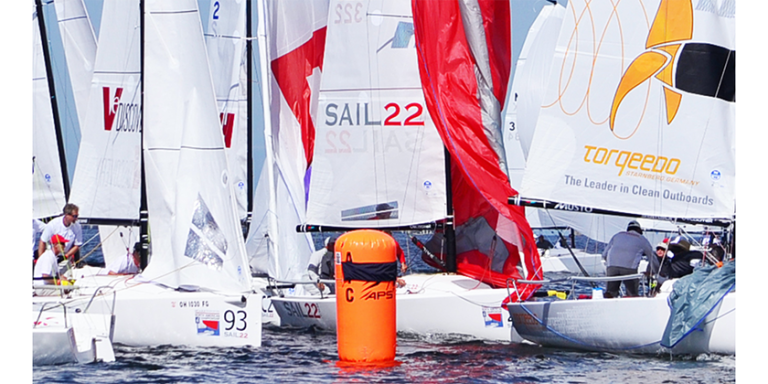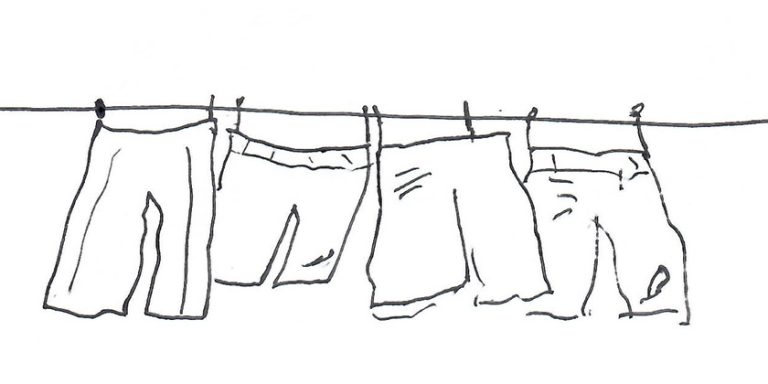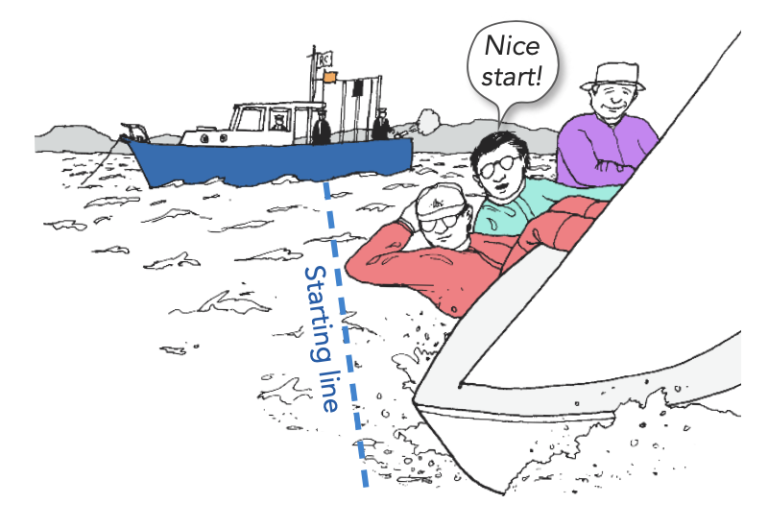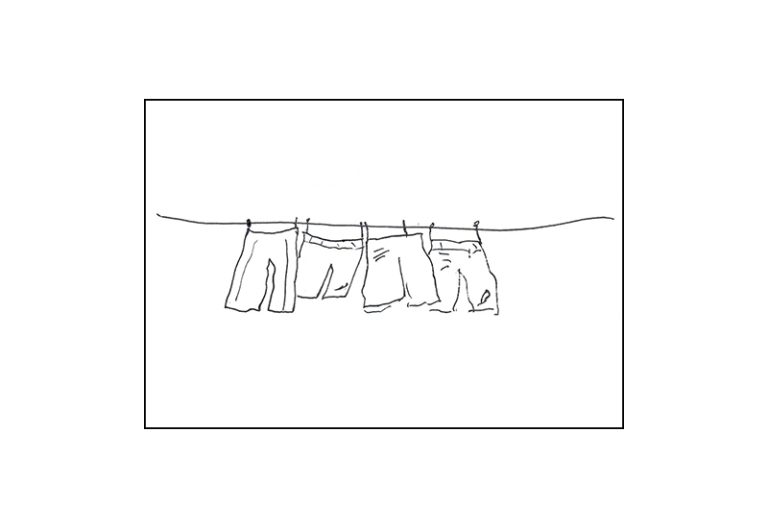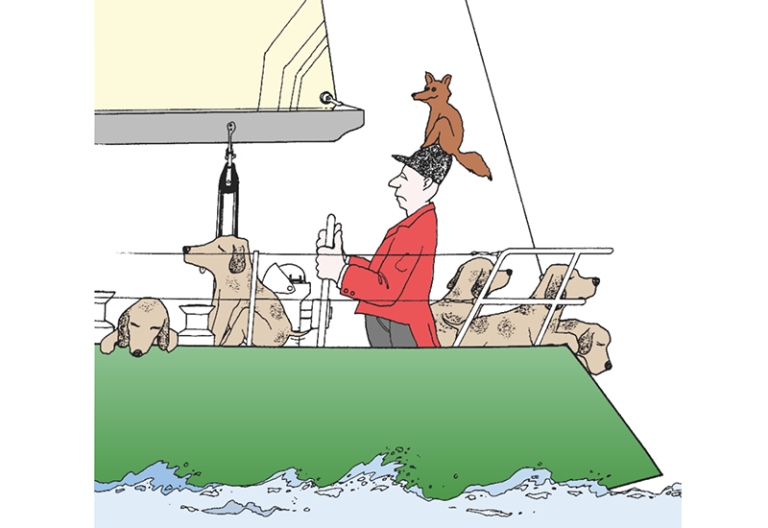Speed & Smarts: Headstay Sag – Control Power with Luff Sag
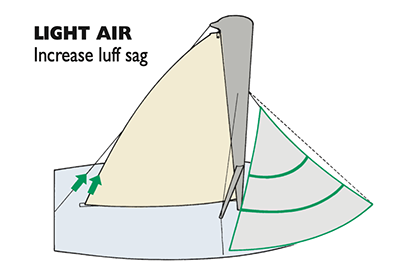
November 30, 2022
One of the most critical factors for any jib or genoa trimmer is the amount of sag in the headstay. Your forestay almost never forms a straight line between the bow and the mast – due to wind pressure it always sags aft and to leeward at least a little bit.
When the headstay sags it adds fullness to the jib. Think of laying your jib out flat on the floor; then push the middle of the luff toward the leech. The wrinkle that forms in the sail is the extra fullness created by headstay sag.
Conversely, when you reduce headstay sag (by straightening the headstay), you remove fullness from the middle of the sail. This is a lot like bending the mast more to make your mainsail flatter.
The primary way to fine tune the amount of power in your headsail is by adjusting headstay sag. In light air and waves, add luff sag to make the sail more powerful and deeper. In heavy air and flat water, remove luff sag to improve pointing and avoid being overpowered.
Unfortunately, the jib trimmer doesn’t usually have control over two things that have the greatest effect on headstay sag – backstay and mainsheet. So, it’s important to communicate and work with your helmsperson and mainsail trimmer.
Of course, the backstay affects the shape of the mainsail as much as the jib. However, the mainsail is attached to two rigid spars, so the main trimmer has many other ways to control its shape (e.g. tension on the lowers, position of the mast at the butt and partners). Therefore, jib shape should get priority when adjusting the backstay.
Fortunately, most adjustments made to the mainsail are good for the jib, too. When the boat gets a puff, for example, the skipper trims the mainsheet. This adds bend to the mast, which flattens the main, and also straightens the headstay, which flattens the jib.
Changing the amount of head- stay sag has a huge effect on the overall fullness and power in the sail, and that’s why it should be one of the jib trimmer’s top priorities for shifting gears. However, luff sag also has a big impact on the location of maximum draft in the sail. More sag moves the draft forward
in the sail, while less sag moves the draft aft. Therefore, whenever you change the amount of sag, vary luff tension to fine-tune the position of maximum draft.
Four things that affect headstay sag
There are several ways in which a trimmer can reduce or increase the amount of headstay (luff) sag:
1. Backstay – The backstay pulls aft on the top of the mast and has a significant effect on how much the headstay sags. If your boat has running backstays, these affect jib shape even more because they at- tach to the mast right at the hounds where the headstay also attaches.
2. Mainsheet – The sheet pulls directly on the top of the mast (via the leech of the sail) and therefore has a large impact on luff sag, especially on boats without a backstay.
3. Boom vang – The vang pulls the mainsail leech tight and may have a large influence on sag, but only if it is anchored to the boat (if it attaches to the mast, it won’t have nearly as much effect on sag).
4. Overall rig tension – When the upper shrouds are based aft of the mast, tensioning them will pull the top of the rig aft and reduce luff sag. This is a key control on boats that don’t have backstays.
You want a good bit of headstay sag when you are under-powered and whenever it’s more important to foot than point. This is generally whenever the breeze is light, when you have more waves than wind, or when you need to accelerate. Sag moves the luff of the sail aft (closer to the leech), and thereby adds depth to the jib. This added depth will be most noticeable in the forward part of the sail and in the upper half where the sag is larger relative to the sail’s chord length.
How to increase sag: There are several ways to do this: 1) Ease your mainsheet and/or vang; 2) Let off on the backstay or running backstay; or 3) Loosen your overall rig tension.
What it does: By increasing headstay sag, you add fullness to the jib or genoa, especially in the forward sections. This fuller shape gives you more power for acceleration and better speed in light air or waves, plus a more forgiving ‘groove.’
Trimming comments: Loosening the headstay rounds up the front of the sail, so you should simultaneously ease the sail’s luff tension, or the draft will be too far forward.
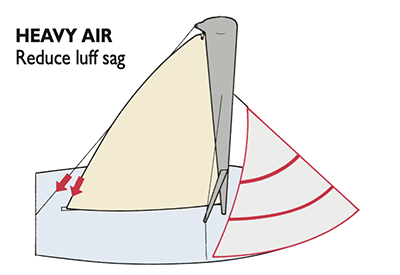 Minimize headstay sag whenever you are overpowered and whenever pointing is important. In general, this is when it’s windy or when you have fewer waves than wind and at least a moderate breeze. But don’t go overboard. If you have too little sag, the entry of the jib will be very fine and make steering difficult. The boat won’t track, and the leeward telltales will stall easily. If this happens, add headstay sag.
Minimize headstay sag whenever you are overpowered and whenever pointing is important. In general, this is when it’s windy or when you have fewer waves than wind and at least a moderate breeze. But don’t go overboard. If you have too little sag, the entry of the jib will be very fine and make steering difficult. The boat won’t track, and the leeward telltales will stall easily. If this happens, add headstay sag.
How to reduce sag: There are several ways: 1) Pull harder on your mainsheet and/or vang; 2) Tighten the backstay or running backstay; and/or 3) Increase your overall rig tension.
What it does: By straightening the headstay you pull full- ness out of the middle of the jib or genoa. This flatter shape lets you point higher and is more efficient in a breeze. How- ever, a flat entry makes steering more critical, and if you hit a lull or waves you may be hurting for power.
Trimming comments: Tightening the headstay moves the draft aft in the sail, so you will have to increase luff tension to keep the draft forward (at 40% – 45% aft of the luff).
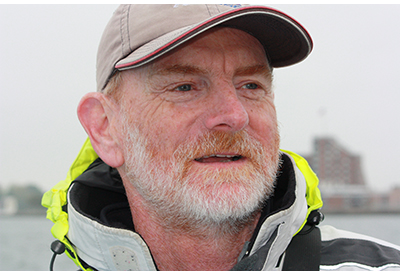 Dave Dellenbaugh is the publisher, editor and author of Speed & Smarts, the racing newsletter. He was the tactician and starting helmsman on America3 during her successful defense of the America’s Cup in 1992 and sailed in three other America’s Cup campaigns from 1986 to 2007. David is also two-time winner of the Canada’s Cup, a Lightning world champion, two-time Congressional Cup winner, seven-time Thistle national champion, three-time Prince of Wales U.S. match racing champion and past winner of the U.S. Team Racing Championship for the Hinman Trophy. He is currently a member of the US Sailing Racing Rules Committee (and was its chairman from 2005-2008).
Dave Dellenbaugh is the publisher, editor and author of Speed & Smarts, the racing newsletter. He was the tactician and starting helmsman on America3 during her successful defense of the America’s Cup in 1992 and sailed in three other America’s Cup campaigns from 1986 to 2007. David is also two-time winner of the Canada’s Cup, a Lightning world champion, two-time Congressional Cup winner, seven-time Thistle national champion, three-time Prince of Wales U.S. match racing champion and past winner of the U.S. Team Racing Championship for the Hinman Trophy. He is currently a member of the US Sailing Racing Rules Committee (and was its chairman from 2005-2008).
You can subscribe to the Speed & Smarts newsletter HERE.

